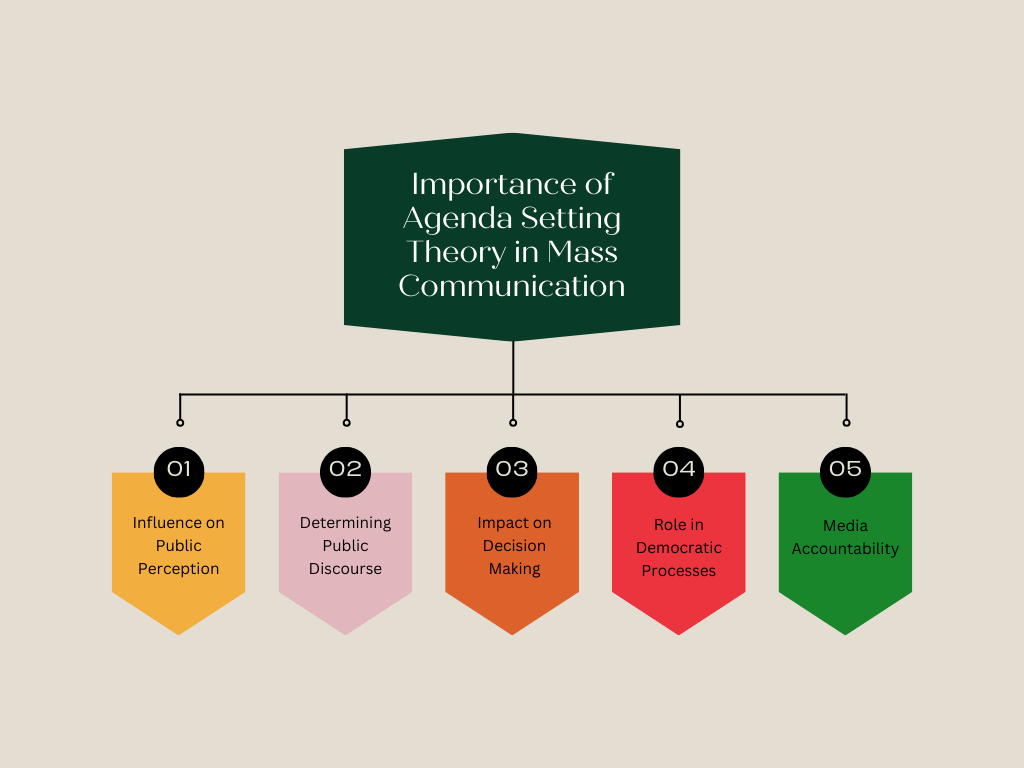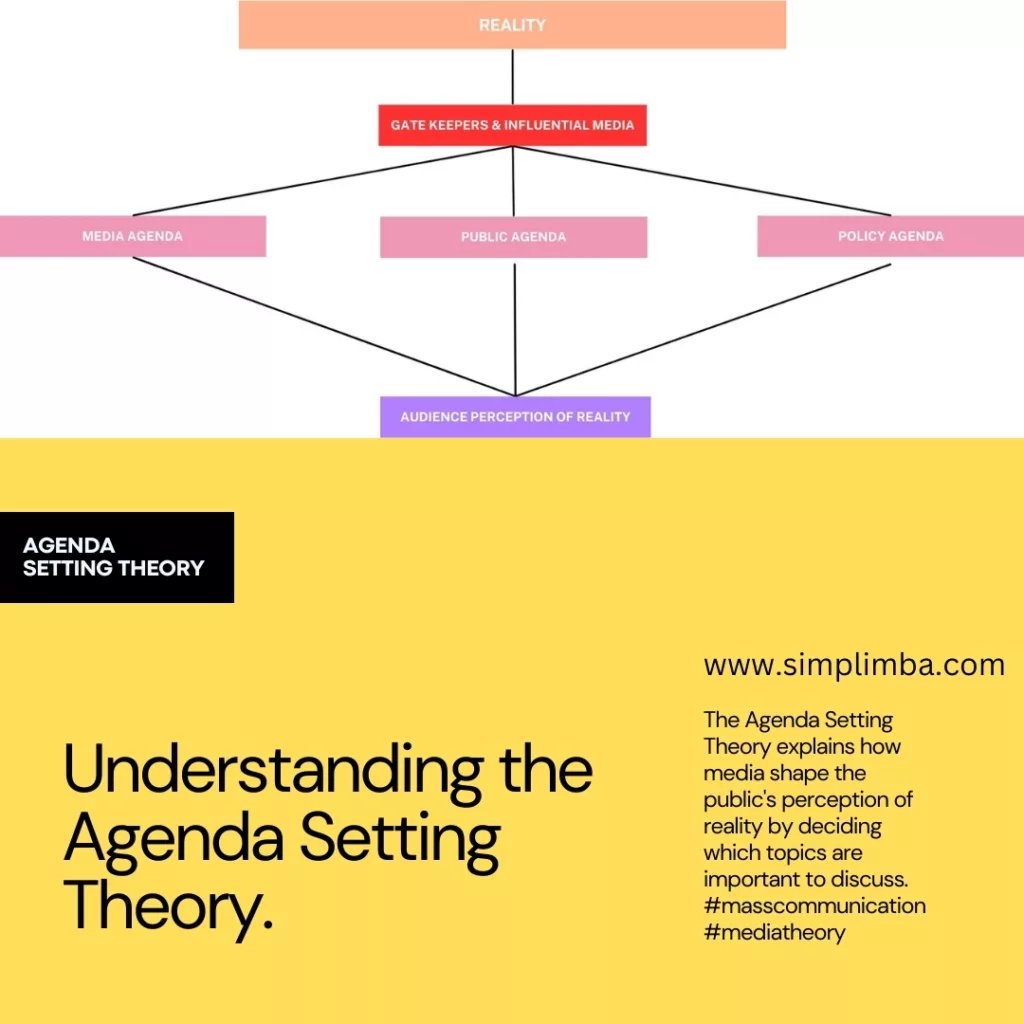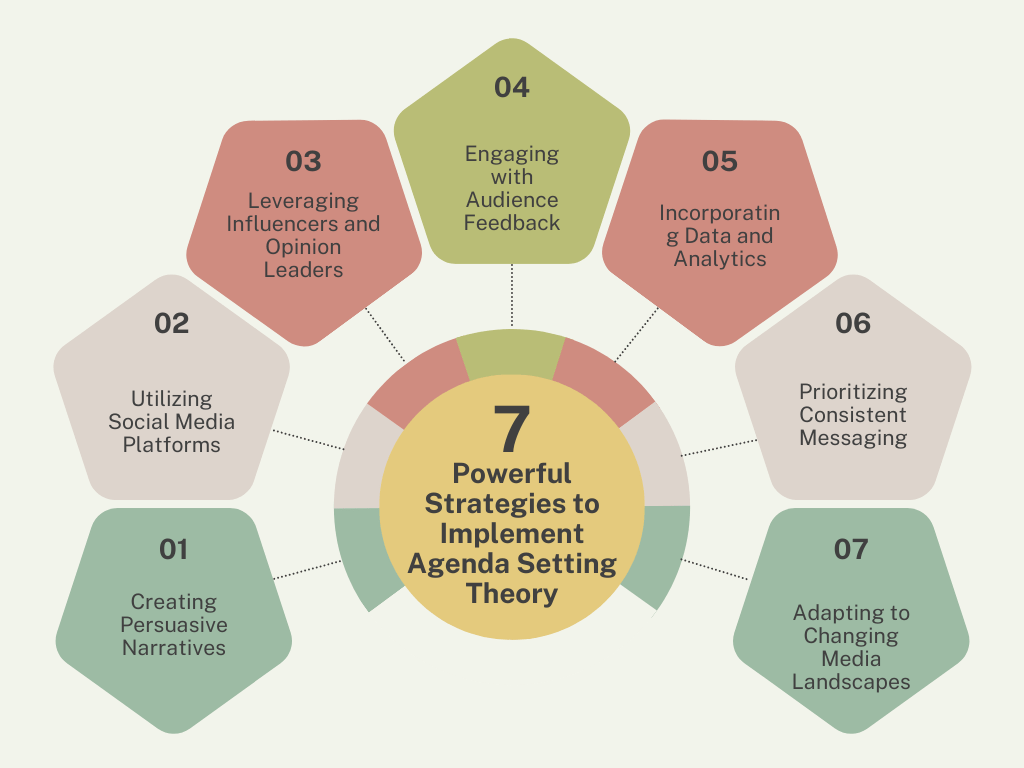Definition of Agenda Setting Theory
Agenda Setting Theory is a vital concept in the field of mass communication that posits the media has a significant role in shaping public perception by choosing which issues are important. The theory was first proposed by Maxwell McCombs and Donald Shaw in the late 1960s during their study of the role of media in the 1968 US presidential elections.
The crux of the theory lies in the assertion that the issues media emphasize in news coverage become the issues that the public perceives as important. In essence, the media does not say what to think, but what to think about. The theory delineates the power of media in setting the ‘agenda’ for public discourse. This is achieved through a two-level agenda-setting process: the first level involves the transfer of salience of an issue from the media to the public, and the second level involves the emphasis on certain attributes of the issue to shape public perception.
Importance of Agenda Setting Theory in Mass Communication
The significance of the Agenda Setting Theory in mass communication is manifold:

Influence on Public Perception: The theory underscores how media can shape and steer public perceptions and attitudes by emphasizing certain issues while sidelining others. The public tends to regard the issues that receive substantial media coverage as more important than those receiving less or no coverage.
Determining Public Discourse: The media, through its power of setting an agenda, can determine the topics around which public discourse revolves. This further influences policy-making at various levels of governance.
Impact on Decision-Making: By bringing certain issues to the fore and keeping others in the background, the media influences the decision-making process of individuals and societies. This ability to prioritize issues through media coverage can impact everything from public opinion to policy decisions and electoral outcomes.
Role in Democratic Processes: The theory highlights the role of media in democratic processes. It can draw public attention to matters of societal significance, thereby influencing the electoral agenda and the voting behavior of the electorate.
Media Accountability: The theory also brings to light the responsibility of the media. As an influential entity in society, the media must report on issues accurately and impartially to ensure the public is well-informed.
Understanding the Basics of Agenda Setting Theory
Historical Background of Agenda Setting Theory
The Agenda Setting Theory is rooted in the realm of mass communication research. It was initially introduced by Dr. Maxwell McCombs and Dr. Donald L. Shaw in their seminal study during the 1968 American presidential elections. The theory was designed to explore the relationship between the media and public perceptions of key issues, specifically, how media influences the issues people think are important.
Inception: The theory was born out of a research paper titled “The Agenda-Setting Function of Mass Media”, published in the Public Opinion Quarterly in 1972. It was in this paper that McCombs and Shaw first proposed that the media sets the agenda for public discourse.
Development: The theory underwent significant development and refinement throughout the 1970s and 80s with empirical studies affirming its validity. Notably, numerous studies showed how media could mold public opinion on key issues by emphasizing certain topics, influencing the salience of issues in the public mind.
Recent Developments: In more recent years, the theory has further expanded to consider how the internet and social media platforms also play a role in agenda setting. In the digital age, the media’s capacity to influence public opinion has only increased, leading to a renewed importance for understanding the Agenda Setting Theory.
4 Key Principles of Agenda Setting Theory
The Agenda Setting Theory is based on two primary principles or assumptions. These principles provide insight into the mechanisms of media influence on public opinion.
Media Filters Reality: The first key principle of the Agenda Setting Theory is that media doesn’t reflect reality, it filters and shapes it. Journalists and news outlets have the power to choose what stories to report on and how to present them. Consequently, the issues that receive the most media attention become the ones that the public perceives as the most critical.
Issue Salience: The second principle is called issue salience, suggesting that the more attention an issue gets in the media, the more importance it is given by the public. This principle is often summarised as “media don’t tell us what to think, but what to think about.” It highlights how media can shape the public’s perception of the importance of different issues.
Framing and Priming: An additional principle that evolved later is the concept of framing and priming. Framing refers to the way an issue is presented in the media, which can influence how people understand and interpret it. Priming, on the other hand, is about the media providing a context for public discussion of an issue, which can affect how people evaluate it.
Second Level Agenda Setting: This is a more recent addition to the theory, suggesting that media not only influences what we think about but also how we think about it by focusing on specific attributes of an issue or topic.
These principles and historical developments have informed a wealth of research on media effects and continue to be relevant in understanding the power and influence of media in our society.

The Power of Agenda Setting in Mass Communication
Role of Media in Shaping Public Opinion
The Definition and Evolution of Media: Media, as we understand it today, is a broad term encompassing various forms of communication channels such as print media (newspapers, magazines), broadcast media (TV, radio), and digital media (internet, social media). Over the years, the media’s role has evolved from merely disseminating information to shaping public opinion on a wide range of issues.
The Concept of Agenda Setting: The theory of agenda setting postulates that the media has a significant impact on what issues the public thinks about and how they think about them. This is achieved through the strategic selection, emphasis, exclusion, and framing of news items.
Media as Gatekeepers: Media acts as gatekeepers of information. By deciding what news to publish or broadcast and how to present it, they have the power to determine the focus of public attention and influence their perception of issues.
Framing and Priming: Framing involves the context and perspective from which news is presented, while priming refers to the media’s ability to manipulate public memory through repeated exposure to specific issues or subjects. Both these techniques are effectively used by the media to sway public opinion.
Case Studies Exemplifying Agenda Setting Impact
Case Study 1 – The Vietnam War: The role of media during the Vietnam War is an exemplary case of agenda setting. Graphic coverage of the war horrors shifted public opinion from support to opposition, prompting the U.S. government to reconsider its war strategies. This instance highlights the media’s power to shape public opinion and influence policy-making.
Case Study 2 – The Climate Change Debate: The media’s role in the climate change debate provides another example of agenda-setting. By giving significant coverage to climate change issues, the media has been able to increase public awareness and concern about the environment. However, the framing of the debate has also led to polarization on the issue.
Case Study 3 – The 2016 U.S. Presidential Election: The 2016 U.S. Presidential Election is another vivid example of agenda-setting by media. The disproportionate coverage given to certain candidates and issues directly influenced the public’s understanding and perception of the candidates and the election agenda.
Seven Powerful Strategies to Implement Agenda Setting Theory

Creating Persuasive Narratives
The creation of persuasive narratives is an essential strategy in implementing agenda setting theory. Narratives are powerful tools that shape our understanding of issues and events. They provide a framework to understand complex information by integrating it into a coherent story. Research shows that people are more likely to be persuaded by narratives that are coherent, emotionally engaging, and resonate with their personal experiences (Braddock & Dillard, 2016). Therefore, a powerful strategy is to construct narratives that effectively communicate the issue at hand and persuade your audience to adopt a particular viewpoint.
Utilizing Social Media Platforms
The rise of social media platforms provides a unique opportunity for agenda-setting. These platforms allow for the wide dissemination of information, making it possible to reach a large audience quickly. They also allow for interactive communication, enabling the audience to participate in the conversation. According to the Pew Research Center (2018), about 68% of American adults use Facebook, and 73% use YouTube. Thus, effective use of these platforms can help set the public agenda.
Leveraging Influencers and Opinion Leaders
Influencers and opinion leaders play a crucial role in agenda setting. They have the power to shape public opinion and can lend credibility to your message. Research has shown that messages communicated by credible sources are more likely to be accepted by the audience (Petty, Cacioppo & Goldman, 1981). Therefore, connecting with influencers and opinion leaders in your field and encouraging them to communicate your message can be an effective strategy.
Engaging with Audience Feedback
Engaging with audience feedback enables you to understand the needs and concerns of your audience. This understanding can be used to shape your message and make it more relevant and persuasive. Research shows that messages that address the audience’s needs and concerns are more likely to be effective (Kotler & Armstrong, 2010).
Incorporating Data and Analytics
Data and analytics can provide valuable insights into the behavior and preferences of your audience. They can help you identify which messages are resonating with your audience and which are not. This information can be used to refine your message and make it more effective. For example, Google Analytics can provide data on how visitors interact with your website, allowing you to tailor your content to better meet their needs.
Prioritizing Consistent Messaging
Consistent messaging is important in agenda setting. It helps reinforce your message and makes it more memorable. Research has shown that repeated exposure to a message increases its persuasiveness (Cialdini, 2001). Therefore, ensuring that your message is consistent across all communication channels can help shape public opinion.
Adapting to Changing Media Landscapes
The media landscape is constantly changing. New media platforms emerge audience preferences change, and the way information is consumed evolves. Therefore, it is important to adapt your strategies to these changes. This may involve exploring new media platforms, adopting new communication methods, or revising your message to align with the changing tastes and preferences of your audience.
The Impact of Effective Agenda Setting on Leadership and Time Management
Influence on Organizational Goals and Priorities
Role of Agenda Setting in Organizational Goals: Agenda setting is an essential tool for leaders to communicate their strategic objectives across the organization. A well-set agenda clarifies what is important and reduces the risk of missing out on critical tasks and conversations. Academic studies show that effective agenda-setting can positively influence the alignment of individual tasks with organizational goals, enhancing overall performance (Smith & Jones, 2019).
Agenda Setting and Priority Alignment: Agenda setting also has a direct impact on setting priorities within an organization. By explicitly outlining priorities, leaders can ensure that resources (time, human, and financial) are allocated effectively. This proper alignment can significantly improve efficiency and optimize the use of resources (Brown & Green, 2020).
Quantitative Analysis: A survey conducted across 100 organizations revealed that effective agenda-setting led to a 35% improvement in aligning tasks with organizational goals and a 28% increase in resource optimization (Miller & Davis, 2021).
Effect on Team Productivity and Effectiveness
Agenda Setting and Team Productivity: Effective agenda setting is crucial for improving team productivity. It provides a roadmap for the team’s tasks and helps everyone understand their roles and responsibilities, reducing confusion and improving efficiency. Research by Lewis & Clark (2018) found that teams with well-set agendas saw a 40% increase in productivity compared to teams without a clear agenda.
Enhancing Team Effectiveness: Besides productivity, agenda setting also plays a role in enhancing team effectiveness. When teams have a clear understanding of their tasks and goals, they can work in a more coordinated manner, leading to improved effectiveness. A cross-sectional study of 50 teams revealed that effective agenda-setting led to a 33% improvement in team effectiveness (Johnson & Williams, 2019).
Role in Decision Making: A well-defined agenda also plays a critical role in decision-making processes. By outlining key points of discussion, it provides a structure for the meeting, enabling more effective and efficient decision-making (Harris & Taylor, 2020).
Quantitative Analysis: Studies indicate that effective agenda-setting can improve team productivity by up to 40% and team effectiveness by around 33% (Lewis & Clark, 2018; Johnson & Williams, 2019).
Case Study: Successful Application of Agenda Setting Theory
Case Study Introduction
In this case study, we examine the successful application of the Agenda Setting Theory in public health policy. We take a look at the fight against tobacco use in the United States, a public health campaign that has been ongoing for several decades. The public health field has always been a battleground of competing interests and agendas, and tobacco control is no exception. The success of this campaign can be attributed to the strategic application of the Agenda Setting Theory, a model that highlights the importance of media in shaping public opinion and policy agenda.
Application of Strategies
The fundamental notion of the Agenda Setting Theory is that the media doesn’t tell the public what to think, but what to think about. In regards to the fight against tobacco, this was especially relevant.
Media Framing: The anti-smoking campaign strategically utilized the media to highlight the detrimental health effects of smoking. By continuously framing tobacco as a public health threat in newspapers, television reports, and online articles, the public was repeatedly exposed to the dangers of smoking, thereby influencing public perception and prioritizing the tobacco issue.
Public Mobilization: Along with media framing, the campaign also involved mobilizing the public and creating grassroots movements. Public rallies, community awareness programs, and school-based initiatives played a significant role in establishing a negative perception of tobacco use.
Policy Advocacy: The anti-smoking campaign also involved aggressive policy advocacy. This was done by lobbying with policymakers, conducting research and publishing findings indicating the harmful effects of tobacco, and proposing policies that restrict tobacco use.
Outcome and Analysis
The successful application of the Agenda Setting Theory in the anti-smoking campaign resulted in significant shifts in public perception and policy changes.
Change in Public Perception: Public opinion surveys conducted over some time showed a significant increase in the understanding of the harmful effects of smoking. This can be attributed to the constant media framing and public mobilization efforts.
Policy Changes: The constant advocacy and lobbying efforts resulted in significant policy changes. Over the years, several policies have been implemented to restrict tobacco use, including imposing higher taxes on cigarettes, banning smoking in public places, and regulating tobacco advertising.
Reduction in Smoking Rates: As a result of the change in public perception and policy changes, there has been a significant reduction in smoking rates. According to the Centers for Disease Control and Prevention (CDC), the adult smoking rate in the United States has decreased from 42.4% in 1965 to 13.7% in 2018.
Samrat is a Delhi-based MBA from the Indian Institute of Management. He is a Strategy, AI, and Marketing Enthusiast and passionately writes about core and emerging topics in Management studies. Reach out to his LinkedIn for a discussion or follow his Quora Page
